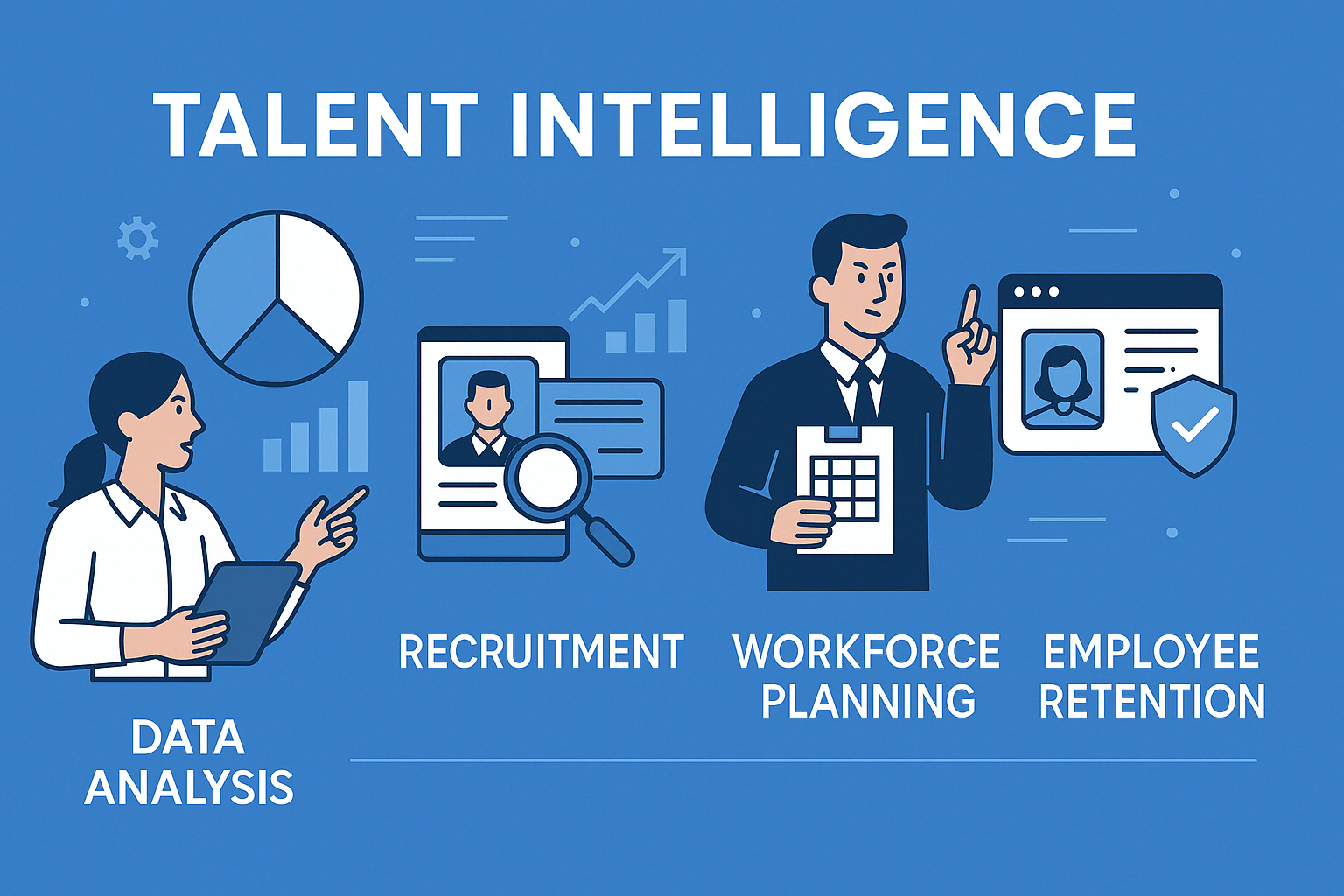Talent Intelligence: Unlocking Strategic Workforce Insights
Introduction
In the rapidly evolving landscape of Human Resources, businesses are increasingly turning to advanced analytics to drive their talent strategies. Talent Intelligence is emerging as a crucial practice, harnessing data to provide organizations with valuable insights about their workforce, competitors, and industry trends, thereby transforming how companies attract, retain, and develop talent.
What is Talent Intelligence?
Talent Intelligence is the strategic process of collecting, analyzing, and interpreting workforce data to make informed talent decisions. It leverages internal data (employee performance, skills inventories, retention rates) and external market data (competitor analysis, labor market trends, compensation benchmarking) to shape HR policies, talent acquisition, development programs, and succession planning.
Talent Intelligence tools often utilize AI and machine learning to rapidly process vast amounts of information, generating actionable insights and predictive analytics.
Why Talent Intelligence Matters
Talent Intelligence enables organizations to:
Enhance Talent Acquisition:
Identify the best talent pools, predict hiring trends, and streamline recruitment processes.Improve Retention and Engagement:
Uncover factors driving employee turnover and proactively address retention risks.Support Strategic Workforce Planning:
Anticipate skill gaps, understand future talent needs, and align workforce planning with organizational goals.Strengthen Competitive Advantage:
Benchmark against industry competitors and adapt proactively to changing market conditions.
Core Components of Talent Intelligence
1. Talent Market Analytics
Analyzes external labor market conditions, including talent availability, skill shortages, and competitor hiring strategies.
2. Internal Workforce Analytics
Evaluates internal talent dynamics such as skills inventory, employee engagement, turnover rates, and career progression.
3. Predictive Talent Analytics
Uses historical data and machine learning algorithms to predict employee turnover, hiring success, future skill needs, and succession readiness.
4. Competitor Benchmarking
Compares internal practices against competitors, including compensation, employee benefits, and talent acquisition effectiveness.

Real-world Applications of Talent Intelligence
Talent Acquisition
Predictive hiring analytics
Competitor talent pool analysis
Automated candidate matching using AI algorithms
Employee Retention
Predictive attrition models
Employee sentiment analysis
Retention risk alerts and proactive interventions
Succession and Workforce Planning
Forecasting critical role vacancies
Identifying internal talent with succession potential
Strategic scenario planning based on industry changes
How to Implement Talent Intelligence
Step 1: Define Strategic Objectives
Clearly outline talent-related business questions and goals. Align Talent Intelligence initiatives directly with business objectives.
Step 2: Gather Relevant Data
Combine internal HR data (performance, skills, turnover) with external market insights (industry trends, salary benchmarks).
Step 3: Leverage the Right Tools
Choose advanced analytics tools or Talent Intelligence platforms capable of integrating and analyzing diverse data sets.
Step 4: Analyze and Act
Interpret findings and translate insights into strategic actions, such as targeted recruitment campaigns, customized retention programs, and precise learning and development plans.
Step 5: Monitor and Refine
Regularly review and refine your Talent Intelligence strategy based on new data and changing organizational priorities.
Benefits of Talent Intelligence
Enhanced Recruitment Efficiency: Quickly identify ideal candidates, shortening time-to-fill roles.
Reduced Turnover Costs: Early identification of turnover risks allows for proactive retention strategies.
Optimized Workforce Planning: Align workforce capabilities with long-term strategic goals, avoiding costly skill gaps.
Improved Employee Experience: Insights into employee needs facilitate targeted engagement initiatives.
Common Challenges and How to Overcome Them
Challenge | Solution |
|---|---|
Data Quality & Integration | Invest in standardized data management systems and establish clear data governance protocols. |
Analytics Skill Gap in HR | Provide training or hire dedicated analytics specialists to support HR teams. |
Resistance to Data-driven Culture | Promote internal success stories and continuously educate stakeholders on the benefits of data-informed decision-making. |
Future Trends in Talent Intelligence
AI-Powered Predictive Hiring: Increasingly sophisticated algorithms will predict hiring success and cultural fit with unprecedented accuracy.
Real-Time Talent Market Monitoring: Continuous scanning of talent market shifts, enabling dynamic and agile workforce adjustments.
Integration with Employee Experience Platforms: Seamless connections between analytics, performance management, and employee engagement systems.
Ethical and Transparent AI Use: Increased emphasis on data privacy, ethical considerations, and algorithmic transparency to build trust and compliance.
FAQ about Talent Intelligence
Q1: How does Talent Intelligence differ from traditional HR analytics?
Talent Intelligence expands traditional HR analytics by incorporating external labor market insights and competitor benchmarking, offering a broader and more strategic view of talent management.
Q2: Can Talent Intelligence help small organizations?
Yes. Even smaller organizations benefit significantly by using Talent Intelligence to optimize hiring, reduce turnover, and strategically plan workforce development with limited resources.
Q3: What role does AI play in Talent Intelligence?
AI processes vast datasets rapidly, providing predictive analytics, talent matching, market scanning, and real-time decision support that manual analysis can't efficiently accomplish.
Q4: What are some leading Talent Intelligence platforms?
Examples include LinkedIn Talent Insights, Eightfold AI, SeekOut, and Visier. Each offers specialized capabilities in market analytics, predictive talent management, and candidate matching.
Related HR Glossary Terms
HR Glossary: Master the Language of Modern HR
Conclusion
Talent Intelligence transforms HR from reactive management to proactive strategic partnership. By leveraging powerful analytics, businesses can precisely target recruitment efforts, develop more effective retention strategies, and make smarter workforce planning decisions. Organizations investing in Talent Intelligence today are building the resilient, future-ready workforce needed for long-term competitive advantage.
From recruiting candidates to onboarding new team members, MokaHR gives your company everything you need to be great at hiring.
Subscribe for more information

